Medical expert of the article
New publications
Preparations
Ointments for keloid scars
Last reviewed: 03.07.2025

All iLive content is medically reviewed or fact checked to ensure as much factual accuracy as possible.
We have strict sourcing guidelines and only link to reputable media sites, academic research institutions and, whenever possible, medically peer reviewed studies. Note that the numbers in parentheses ([1], [2], etc.) are clickable links to these studies.
If you feel that any of our content is inaccurate, out-of-date, or otherwise questionable, please select it and press Ctrl + Enter.
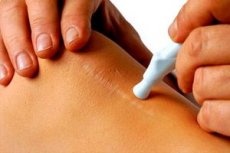
It is ointments that are the medicinal form that allows you to quickly and effectively get rid of skin defects, including keloid scars.
In modern medicine, you can find many different products that help people get rid of unsightly scars. Of course, no product can guarantee that they will disappear completely, but it is quite possible to make them less noticeable. Today, there are many ointments that help scars dissolve quickly. For an ointment to be effective, it must contain the active component allantoin. It helps to retain moisture in the damaged skin longer.
Doctors today offer many popular methods that help the scar to dissolve faster (laser procedure, deep skin peeling), but all of them are carried out in special rooms and are quite expensive. Ointments are a more popular method, because they can be used even at home. Among the most popular absorbable ointments are: Contractubex, Clearvin, Dermatix, Kelofibrase, Zeraderm Ultra.
Indications ointments for keloid scars
Before choosing a suitable drug, it is necessary to pay attention to the types of scars and cicatrices. After all, the effectiveness of a particular remedy will depend on this:
- Normotrophic - are considered a standard reaction of the human body to an injury. Such scars are located at the same level with healthy skin and become almost invisible over time.
- Hypertrophic - located at the edges of the wound and slightly protrude above the healthy skin. May appear if the wound is infected.
- Keloid - have the form of tumors that grow along the connective tissue. They are dense to the touch and always protrude very strongly above the skin.
- Atrophic - thinned tissue that begins to sink into the wound. Gathers into thin folds.
Release form
Today, you can find a huge number of different ointments for keloid scars in pharmacies. Which of them will be the most effective in your particular case, only a specialist can determine. But the following drugs are considered the most popular:
- Contractubex ointment.
- Heparin ointment.
- Dermatix.
- Clearvin ointment.
- Vishnevsky ointment.
- Methyluracil ointment.
- Zinc ointment.
- Tetracycline ointment.
- Solcoseryl ointment.
- Chinese ointment.
- Rescuer ointment.
- Hydrocortisone ointment.
- Salicylic ointment.
- Actovegin ointment.
Contractubex ointment
A popular remedy used to treat scars and cicatrices, especially keloid type, with proteolytic action based on onion extract (in liquid form), allantoin, sodium heparin.
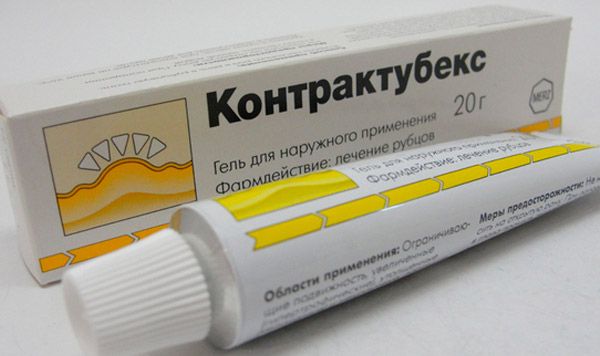
The ointment is used at a rate of 0.5 cm of the product per 25 cm² of skin. It is recommended to use it two to three times per 24 hours, rubbing the ointment into the keloid scar with light massage movements. Fresh scars are treated for about four weeks.
If the keloid scar is old and already has a dense surface, the ointment is best applied under a bandage. In this case, the therapy can last up to six months. Do not apply to granulation. Patients with intolerance to the components of the ointment are prohibited from using it. Rarely, patients complain of allergic reactions that occur after using the drug.
Heparin ointment
A medicine with an antithrombotic effect. The medicine contains the following active components: benzyl nicotinate, sodium heparin, benzocaine. Sodium heparin, gradually released in the body, begins to slowly act on the inflammatory process. Dissolves old blood clots and prevents new ones from appearing.
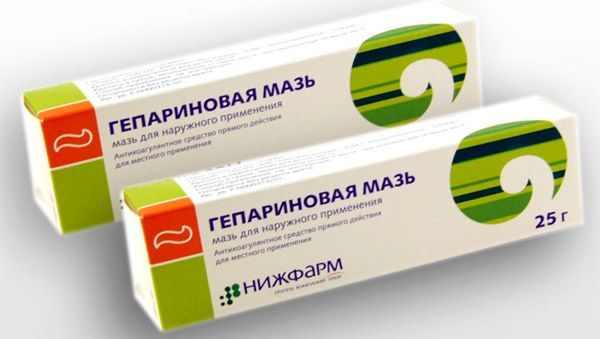
It is recommended to apply the ointment in a small amount (2 cm) only to the surface of the wound or scar (if the damaged skin does not exceed 5 cm). Rub in with gentle movements. Use two to three times per 24 hours until the patient sees a positive effect.
Patients with ulcerative and necrotic processes in tissues, skin injuries, intolerance to the components of the drug are prohibited from using it. In rare cases, patients noted that the use of the ointment leads to hyperemia of the skin, as well as allergies.
Dermatix
A transparent silicone gel that dries quickly on the skin after application. The medicine contains the following active ingredients: various compounds with a silicon base, a mixture of polymer organosilicon compounds, silicon dioxide. Due to the fact that Dermatix evenly moisturizes the skin, scars and marks on it gradually decrease.
With the help of this drug, you can get rid of even protruding keloid scars, relieve itching or burning. Reduce pigmentation on the skin. Do not apply to open and unhealed wounds.
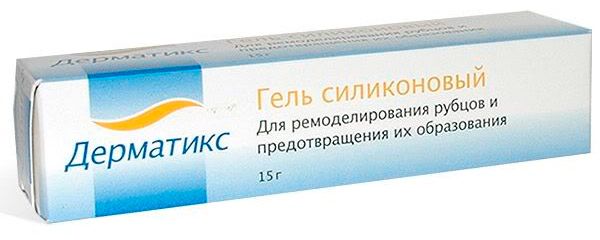
If it is necessary to apply Dermatix to the skin of the eyelids, it should be done very carefully so that the gel does not get into the eyes. Use a thin layer of the preparation for application. Use twice in 24 hours. Before use, the skin should be cleaned with soap and wiped dry. It is recommended to continue treatment for up to two months, but if necessary, the duration can be adjusted by the attending physician.
Patients with unhealed wounds, intolerance to the components of the drug are prohibited from using it. Do not apply together with other dermatological products. Sometimes it can cause allergies (itching, redness, irritation).
Clearvin ointment
A popular Ayurvedic remedy on a natural basis. The medicine contains the following active components: lodhra and vaccha, tulsi and manjistha, beeswax, aloe vera, sesame oil, yashada bhasma and tankan bhasma. Due to this composition, the ointment helps to get rid of scars and marks on the skin, improves the process of cell renewal and their respiratory system. Can be used to treat stretch marks that appear after pregnancy.
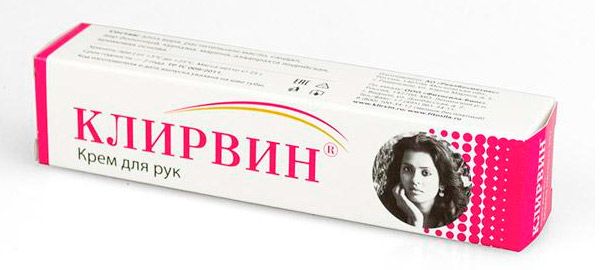
Apply twice a day. For best results, use before bedtime. Rub the ointment thoroughly into the skin until it is completely absorbed. The duration of treatment depends on the patient's age and the condition of the keloid scar. However, the first effective results usually appear as early as the fourth week after the start of use.
It has no side effects, as it is a completely natural remedy. Patients with intolerance to the components of the drug are prohibited from using it.
Vishnevsky ointment
Perhaps the most popular antiseptic that can be found in every person's home medicine cabinet. The medicine contains the following active ingredients: xeroform, tar and castor oil.
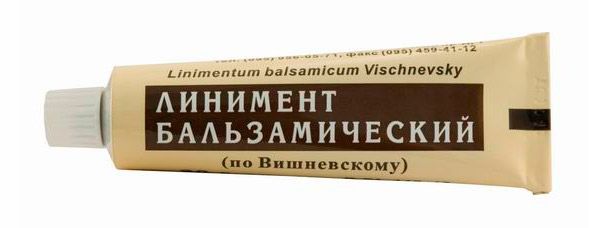
Most often, this ointment is used for frostbite, applying it to the affected skin. This helps to avoid the appearance of a keloid scar. Vishnevsky ointment, despite its unpleasant smell, copes with inflammation, and is also indispensable in surgery. This can be explained by its complete harmlessness.
For the treatment of keloid scars, the dosage of Vishnevsky ointment is recommended by the attending physician, since it depends not only on the severity of the injury, but also on the patient's age. Patients with intolerance to the components of the drug are prohibited from using it. Due to its natural composition, it does not cause any unpleasant sensations or symptoms.
Methyluracil ointment
A medicine used to treat poorly healing wounds, photodermatitis, and to reduce scars. The medicine contains the active ingredient methyluracil. The drug also additionally contains petroleum jelly and lanolin. Due to this, the product helps to improve the process of skin regeneration, and has an anti-catabolic and anabolic effect.
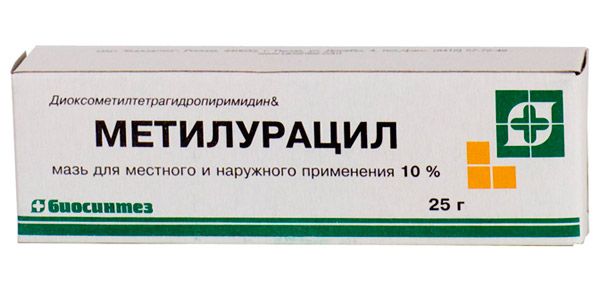
It is recommended to apply the ointment only to the affected areas of the skin or to keloid scars in a small amount (1-2 cm). Use once every 24 hours (if necessary, more, but you must consult with your doctor) for 15-30 days.
Patients with excessive granulation, intolerance to the components of the drug are prohibited from using this ointment. The use of the product can cause headaches, allergies, burning at the site of application, dizziness.
Zinc ointment
A popular medicine that has antiviral, anti-inflammatory and wound-healing effects. The medicine contains the active ingredient zinc oxide. The drug also contains petroleum jelly. Thanks to this composition, the product softens and protects the skin, disinfects wounds, and reduces keloid scars.
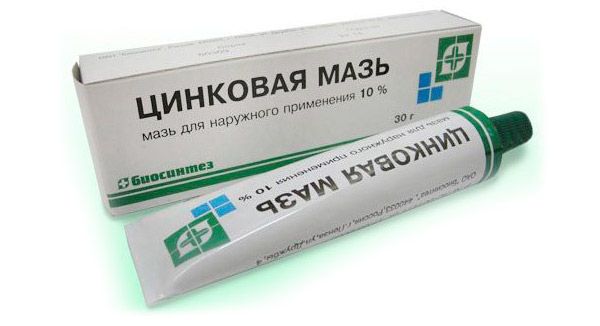
It is recommended to apply the ointment only to the scars or wounds two or three times in 24 hours. Use a small amount (1-2 cm) of the preparation. The frequency of application can be changed by the attending physician. The duration is also determined by the specialist.
Patients with intolerance to the components of the drug, inflammatory or purulent diseases are prohibited from using Zinc Ointment. In some cases, its use can cause hyperemia of the skin, allergies, itching.
Tetracycline ointment
A medicinal antibacterial ointment for external use. It is active against many pathogens (Staphylococcus spp., Streptococcus spp., Haemophilus influenzae, Bacillus anthracis, Listeria spp., Neisseria gonorrhoeae, Escherichia coli, Bordetella pertussis, Klebsiella spp., Shigella spp., Salmonella spp., Chlamydia spp., Rickettsia spp., Treponema spp., Mycoplasma spp.). When applied to a wound, it inhibits the growth and reproduction of bacteria. The active ingredient in the medicine is tetracycline.
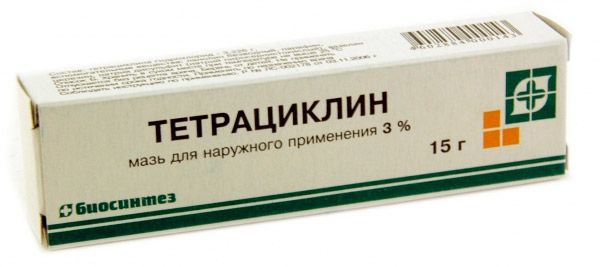
It is recommended to apply not only to the damaged surface, but also to capture a little of the adjacent healthy skin. This will help prevent an increase in the affected area. It can be used under a bandage. The duration of therapy and the dosage of the drug are prescribed by the attending physician.
Patients with tetracycline intolerance, mycotic skin lesions are prohibited from using the product. It is not recommended to use it for treating children under eleven years of age. Sometimes patients complain that the ointment causes photosensitivity, allergies, hyperemia of the skin, itching at the site of application.
Solcoseryl ointment
A medicinal product for improving tissue regeneration and trophism based on deproteinized dealysate, which is extracted from calf blood. Due to this, the drug is able to improve the transport of glucose and oxygen to the body's cells, activates tissue regeneration, and reduces keloid scars.
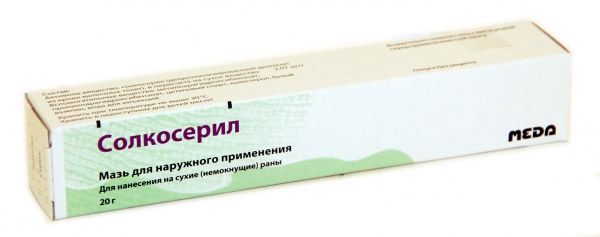
Before using the ointment, it is recommended to thoroughly cleanse the skin and dry it with a towel. Apply a small amount (1-2 cm of the preparation) once or twice in 24 hours. Bandages can be used if necessary. The duration of treatment is determined by a specialist.
Patients with intolerance to the components of the drug, as well as with a predisposition to allergic reactions, are not recommended to use the product. For the treatment of pregnant women, constant medical supervision is required. May cause marginal dermatitis, allergy, burning.
Chinese ointment
A drug that is intended for the treatment of keloid and hypertrophic scars. The drug contains the following active ingredients: gecko extract, medicinal leech extract, collagen, hyaluronic acid.
Apply a small amount of the preparation (1-2 cm) to the affected area (scar) and leave on the skin for three to four minutes. Then wash the ointment off the skin. It is recommended to lubricate the scar two to three times in 24 hours.
Patients with intolerance to the components of the drug are not recommended to use it. In some cases, it may cause allergic reactions.
 [ 13 ], [ 14 ], [ 15 ], [ 16 ], [ 17 ]
[ 13 ], [ 14 ], [ 15 ], [ 16 ], [ 17 ]
Rescuer ointment
A highly effective preparation used to treat various skin lesions and improve the appearance of the skin by reducing scars. The medicine contains only natural active ingredients: vitamin E, propolis, sea buckthorn oil, beeswax, milk lipids, lavender, tea tree and rosemary essential oils, turpentine oil.
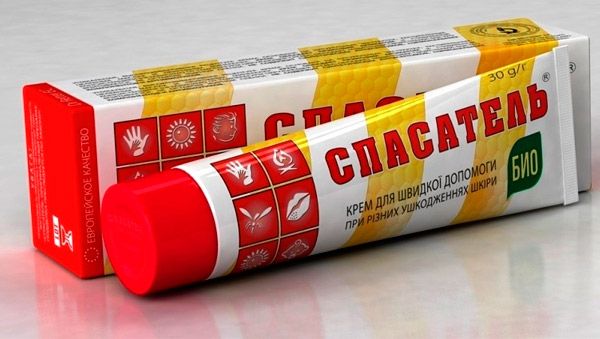
Due to its composition, the product helps to quickly restore the protective structure of damaged tissues. The drug effectively heals wounds and prevents the appearance of keloid scars.
The dosage of the ointment is strictly individual. To reduce keloid scars, only a doctor can recommend a course of therapy and its duration to the patient. Patients with intolerance to the components of the product are prohibited from using it. In some cases, it can cause an allergy.
Hydrocortisone ointment
A hydrocortisone-based product used to treat non-microbial and inflammatory skin conditions. It can also be used to treat scars.
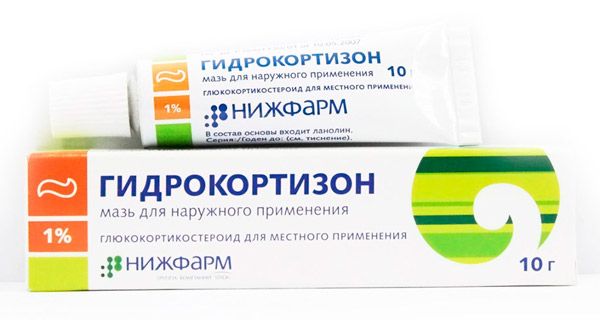
Use only on the site of keloid scars or wounds. Apply a small amount (approximately 1-2 cm of ointment) two to three times in 24 hours. Patients with intolerance to the components of the drug, infectious skin diseases, mycosis, pyoderma, ulcerative lesions are prohibited from using the product. May cause allergies.
Salicylic ointment
A remedy used for inflammation of the skin, for the treatment of wounds, scars, and cicatrices. The medicine contains the active components keratolytic substance and salicylic acid.
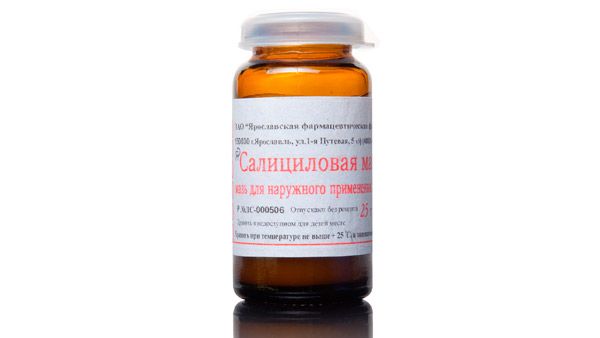
Apply 1-2 cm of ointment to the keloid scar, cover with a napkin (sterile) or bandage. Change the bandage every two to three days. It is not recommended for patients with salicylic acid intolerance or renal failure to use the drug. The ointment is prohibited for treating small children.
The use of the product may cause allergic reactions, itching or burning at the site of application, hyperemia of the skin.
Actovegin ointment
A product that improves tissue regeneration and trophism. The drug contains the active component deproteinized dealysate, which is extracted from calf blood. Due to the increase in cellular metabolism, scars disappear faster, and the skin gets a healthy look.
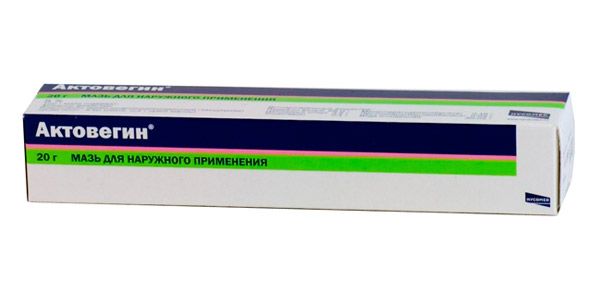
The dosage and duration of therapy for the treatment of scars is determined by the attending physician and depends on the severity of the patient's condition. As a rule, the course lasts at least twelve days.
Patients with intolerance to the components of the drug are not recommended to use it. The ointment can be used to treat pregnant women. It is generally well tolerated, but in some cases it can cause allergies.
Ointment for keloid scars after surgery
In case of superficial wounds or abrasions, the skin is completely restored within one month. But deep and extensive scars, which often remain after surgical intervention, remain on the body much longer. This can be explained by the fact that they contain a lot of collagen.
To reduce the size of such a scar, it is necessary to use special means, among which ointments are in first place. The most popular among them are: ointment Contractubex, Mederma, Golden mustache, Dermatix, Spenko, Scarguard, Mepiform.
Ointment for chickenpox scars
After chickenpox, many patients, especially adults, may be left with keloid scars. They are most often more noticeable on the skin of the face. You can use various medications that will help prevent the appearance of scars.
The most popular means for getting rid of chickenpox scars are the following ointments: Contractubex, Bepanten, Melt. The last ointment based on ginseng root extract, provitamins, green tea extract, calendula extract is considered the best today.
Homemade Ointment for Keloid Scars
Traditional medicine also offers several effective remedies for fighting scars and marks. The most popular recipes are the following:
- Take a few freshly opened buds of white lily, crush the plant until juice appears. Boil unrefined oil, pour it into a jar and add the lily mass with juice there. Leave in a cool and dark place for several weeks. Apply to scars twice in 24 hours.
- Take one gram of mumiyo and one tube of any baby cream. These ingredients must be mixed and applied to the scars once every 24 hours. Leave on the skin for half an hour, then wash off.
- Take spruce resin, beeswax, butter and lard. Mix everything and apply to scars twice a day. Particularly suitable for getting rid of old keloid scars.
Let's consider the pharmacodynamics and pharmacokinetics of ointments for scars using the popular drug "Contractubex" as an example.
Pharmacodynamics
This is a combined product. Its effectiveness is due to the active components that are part of its composition. It has anti-inflammatory, fibrinological, antithrombotic, keratolytic effects. Due to its composition, it inhibits the proliferation of keloid fibroblasts and regenerates cells without hyperplasia.
Pharmacokinetics
Side effects ointments for keloid scars
- Allergy.
- Itching or burning at the site of application.
- Hyperemia of the skin.
- Headaches.
- Dizziness.
- Marginal dermatitis.
- Photosensitivity.
 [ 30 ]
[ 30 ]
Attention!
To simplify the perception of information, this instruction for use of the drug "Ointments for keloid scars" translated and presented in a special form on the basis of the official instructions for medical use of the drug. Before use read the annotation that came directly to medicines.
Description provided for informational purposes and is not a guide to self-healing. The need for this drug, the purpose of the treatment regimen, methods and dose of the drug is determined solely by the attending physician. Self-medication is dangerous for your health.

